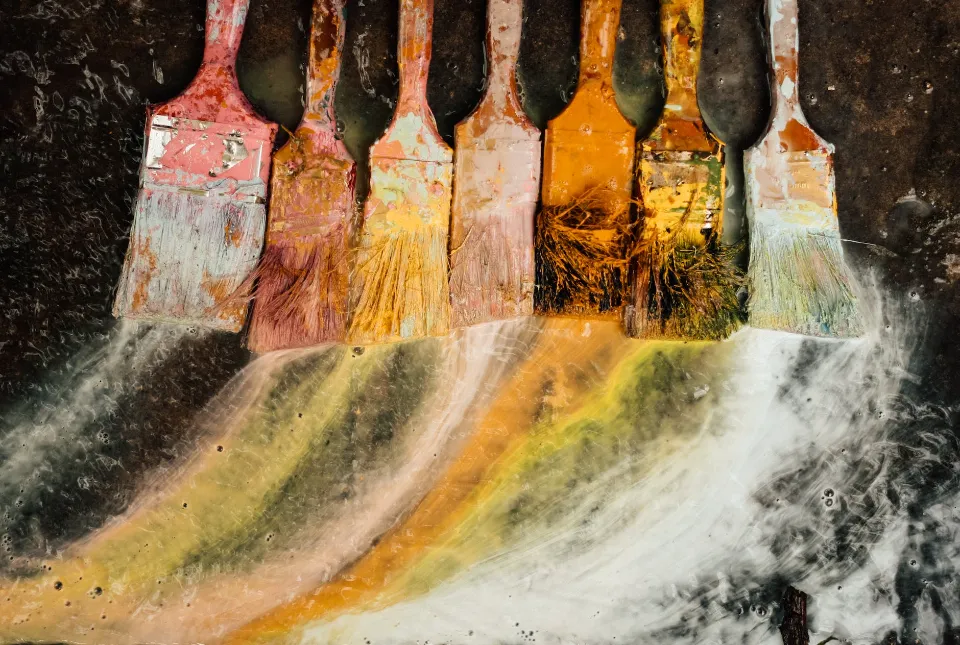An investment in high-quality paint brushes is wasted if they are not properly cleaned and stored after use. Indeed, rushing through the end of a paint job can leave you with flecks of paint in your brushes—which will lead to an imperfect finish on your next project—as well as misshapen bristles. So invest the extra two minutes it takes to do the job right and follow this guide on how to clean paint brushes.

Table of Contents
How Often Should You Clean Paint Brushes
Any kind of paint that is applied should be thoroughly cleaned off a paintbrush after each use.
The only exception is if you must take a brief break—say, an hour or so—but intend to finish your painting project when you get back to it. To place the brush “on hold”, wrap the bristles and the ferrule (the metal component that holds the bristles to the brush handle) in plastic cling wrap. This will stop the paint from drying on the bristles, making it harder to remove later.
What Do You Need
Equipment / Tools
- Sink
- Old bucket or disposable container
- Rags
- Rubber gloves
- Paint brush comb
- Paint brush spinner
Materials
- Paint thinner
- Mineral spirits
- Dishwashing liquid
- Newspaper
How to Clean Paint Brushes With Water-Based Emulsion
1. Remove Paint
Removing as much paint from the brush as you can will help the cleaning process get started. You can do this by wiping on the side of the paint tin. Get a newspaper or something comparable next, and wipe as much as you can onto the paper.
2. Start Washing
Under a running faucet, place the brush with the bristles pointing down, and add some warm water. To help remove the paint, gently massage the bristles with your thumbs and forefingers. Keep going until the water runs clear. Get a paintbrush comb and go through the brush to finish. This makes sure you have a very clean paintbrush by helping to remove paint that is on the ferrule and in the middle of the bristles.
3. Shake Or Spin
As soon as the brush has been thoroughly cleaned, you should drain as much of the extra water as you can. Start by giving it a hand squeeze. Most of the water will be removed in this way.
You can flick the water in a shaking motion, but it’s best to do this outside as it might leave paint traces. Another, and less messy option, is to spin dry. Put the brush handle in the middle of your hands and rub your hands together. In the sink, a bucket, or an empty paint can, carry out this task. To complete the task, you can purchase paintbrush spinners.
4. Store Properly
Once your paintbrush is dry give it a final comb with your paint brush comb to get all the bristles back in place. Your brushes can now be hung up to dry or placed flat. One suggestion is to keep your brushes in the sleeve that they came in to keep them clean and in good shape. Alternatively, when dry, wrap in newspaper.

How to Clean Paint Brushes With Oil-Based Paints
1. Remove Paint
Start by scraping off as much paint as you can. After doing this, you must submerge the brush in the proper solvent. On the majority of oil-based paints, white spirit or a specialized brush cleaner will work. But first, make sure you read the manufacturer’s instructions.
2. Clean in Solvent
Fill a container with your solvent. An old jam jar is a good choice for brushes up to two inches. Cut the top off a two- or four-pint plastic milk container to make larger brushes. Alternately, use any available container that is the right size. To break up the paint, stir the brush in the solvent for 10 to 20 seconds.
3. Wash in Warm Soapy Water
The brush should then be washed in a sink or bucket filled with warm, soapy water. The paint will drip if the brush is moved carelessly. For the purpose of removing the solvent and paint from the brush, run your fingers through some warm, soapy water. To remove any remaining paint that is stubborn, finish by brushing with a paintbrush comb.
4. Spin and Dry
As much water as you can now be removed from the brush by giving it a squeeze with your hand. Put the brush handle between both hands and move like you are rubbing your hands. Do this in the sink, or a bucket or empty paint can. Dry naturally by spreading out or hanging.

How to Clean Hardened Paint Brushes
The easiest way to un-stiffen a paintbrush after the paint has dried is to soak it in water (for water-based paints) or solvent (for oil-based paints) for a few hours to soften the paint, and then comb it with a paintbrush comb. For the brush to be fully restored, you might need to repeat this procedure.
A non-chemical solution is to boil white vinegar, pour it into a container, let it cool for ten minutes, then soak your brush in it for 30 minutes. Then take out and brush through with a paint brush comb
If none of these options work for you or you lack the time or patience, just buy a new brush. Just be sure to take good care of it.
Dispose of the Solvent
Never pour paint thinners or oil paints into a sanitary sewer or sink drain. To let the solvent evaporation and paint drying, keep the open container in a well-ventilated area. Follow the recommendations of your local municipality for safe disposal.
It’s important to note that this process may take several days, and the fumes will remain flammable the entire time, so an indoor spot may not be the best solution. Make sure that children and pets cannot access it if you leave it outside.
Summary
Better results are achieved when using high-quality paint rollers or brushes, whether you’re painting a wall, finishing furniture, or creating art. Since they are also expensive, you want them to last as long as possible, which calls for proper cleaning.
Whether you’re painting with lacquer, oil-based paint, or water-based paint will affect the cleaning technique you use. Oil-based products need a petroleum- or citrus-based solvent to remove them, whereas water-based paints can be cleaned with soap and water.
FAQs
Is It OK to Clean a Paintbrush in the Sink?
Never wash paintbrushes in the sink. The biggest reason is paint can ruin a septic system. A small amount of paint can result in obstructions, contamination, a flammable hazard, and expensive repairs.
What Dissolves Dried Paint?
Paint can be removed gently by scraping it off with a putty knife or plastic scraper (pro tip: vegetable oil can be used to soften the paint). Denatured alcohol or acetone will work on tougher areas but be sure to spot test beforehand.
How Do You Clean Brushes Without Damaging Them?
A tablespoon of either clarifying shampoo or gentle shampoo should be added to a bowl of lukewarm water. The bristles may become dry if you use just regular soap and water. Within the bowl, twirl each brush tip. For a good lather, you can also massage each brush tip in the palm of your hand.
What is the Best Way to Clean Paint Brushes and Rollers?
Combine dish soap and warm water in a bucket. Remove the roller from the frame, submerge the roller into the bucket and while wearing gloves, massage the roller’s fibers to remove caked-on paint. Rinse the roller with a hose or in another bucket of clean water until all paint is removed.





